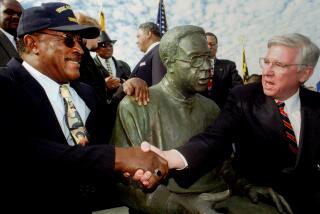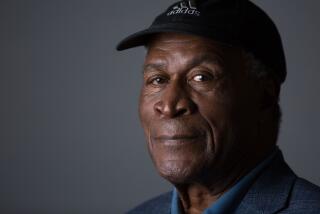Amos Polishes His Act, Takes a Shine to Movies
- Share via
Amos Manuel has spent more than four decades stooped at people’s feet, smearing shoe polish with hands as black and rough as emery, and buffing it in quick, rhythmic strokes that say he has done one thing most of his life: shoeshine man.
One fine January day in the twilight of Manuel’s life, fortune called. Cinewest, a production company, asked to use Amos’ Shoeshine for a few scenes in “Break of Dawn,” a film being shot in San Diego. He agreed, and was offered a bit part. He would be famous Amos.
But somehow, the plot line got mixed up. Amos Manuel was immortalized in celluloid Monday propped high in one of his own chairs, receiving a shine from a movie extra whom he quickly taught the skills he has polished for 41 years.
“They said they needed an extra this morning,” the 70-year-old Manuel said during a pause between scenes. “I presumed that they might have me doing somebody else’s shoes, you know. . . . Instead, they’re doing my shoes.
“I’d rather be the guy doing the shining. I feel out of place up there. But it’s nice to have someone shine your shoes.”
What at first seems to be one of life’s small contradictions actually makes perfect sense in the context of the film. “Break of Dawn” chronicles the life of Pedro Gonzalez, who pioneered Spanish-language radio at KMPC and KELW in Los Angeles during the 1920s and 1930s. In the heavily Latino setting of the film, shoeshine men were Mexican-Americans, not blacks, said screenwriter-director Isaac Artenstein.
With the addition of a block letter “R,” Amos Shoeshine, on 8th Avenue near C Street, became Ramos’ Shoeshine in 1930s Los Angeles. The chairs were covered. A newsstand was set up next door, featuring a 1930s issue of Time magazine with Upton Sinclair on the cover, “Review of Reviews” magazine and “Real, The Exciting Magazine.” Manuel’s old Hires Root Beer vending machine was hauled outside to the sidewalk.
And they took down Manuel’s nude pinups. “We convinced him that they weren’t period nudes,” Artenstein said.
“That’s all right,” Manuel said. “They’ll change it back. They’ll put it back.”
Manuel handled 15 takes flawlessly. His craggy face set between a brown homburg and a peacock-feather patterned tie, he mimed chatter with a customer waiting in the seat next to his. He smoked his first cigar in 21 years, breaking a vow made the day he got drunk and bet his best friend he could stop smoking.
Manuel wasn’t complaining about the break from his routine. Because of the Martin Luther King Day holiday, business would have been slow, and the $100 he received from Cinewest for use of his stand would help pay the rent. The film, he figures, might bring him some business, which has dropped off nearly 25% in recent years.
“Anything to stimulate business downtown,” he said.
Manuel’s stint in the shoeshine chair was actually the second of his career. In the early 1970s, KGTV newsman Jack White featured him in a piece about Manuel’s shoeshine stand.
“To end it, we had Amos sit down and I shined his shoes,” White said. “As I kept trying to sign off, he was telling me that I wasn’t doing it right.”
Monday, Manuel made sure that extra Tim Zito got it right, giving him a quick lesson in the techniques of the shoeshine trade.
“I showed him how to do it first,” he said. “I showed him what to start off with. After that, I showed him how to fake it.”
After 15 takes, Manuel “has got the shiniest shoes in town,” Zito said.
And Zito has a future in shoeshine, Manuel concluded. “He’s got the moves and the rhythm,” Manuel said. “He’s just got to keep it off my socks.”
More to Read
Only good movies
Get the Indie Focus newsletter, Mark Olsen's weekly guide to the world of cinema.
You may occasionally receive promotional content from the Los Angeles Times.










